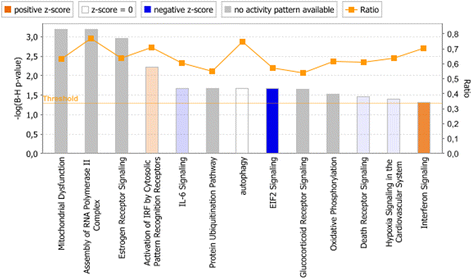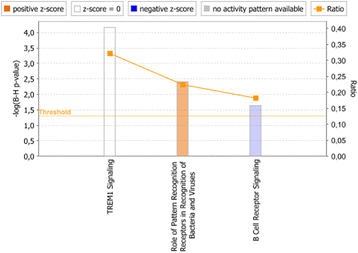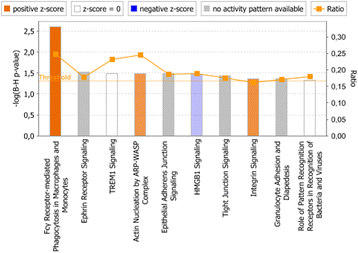Transcriptomic data from two primary cell models stimulating human monocytes suggest inhibition of oxidative phosphorylation and mitochondrial function by N. meningitidis which is partially up-regulated by IL-10
- PMID: 29078758
- PMCID: PMC5659018
- DOI: 10.1186/s12865-017-0229-5
Transcriptomic data from two primary cell models stimulating human monocytes suggest inhibition of oxidative phosphorylation and mitochondrial function by N. meningitidis which is partially up-regulated by IL-10
Abstract
Background: Biological interpretation of DNA microarray data may differ depending on underlying assumptions and statistical tests of bioinformatics tools used. We used Gene Set Enrichment Analysis (GSEA) and Ingenuity Pathway Analysis (IPA) to analyze previously generated DNA microarray data from human monocytes stimulated with N. meningitidis and IL-10 ("the model system"), and with meningococcal sepsis plasma before and after immunodepletion of IL-10 ("the patient plasma system"). The objectives were to compare if the two bioinformatics methods resulted in similar biological interpretation of the datasets, and to identify whether GSEA provided additional insight compared with IPA about the monocyte host response to meningococcal activation.
Results: In both experimental models, GSEA and IPA identified genes associated with pro-inflammatory innate immune activation, including TNF-signaling, Toll-like receptor signaling, JAK-STAT-signaling, and type I and type II interferon signaling. GSEA identified genes regulated by the presence of IL-10 with similar gene sets in both the model system and the patient plasma system. In the model system, GSEA and IPA in sum identified 170 genes associated with oxidative phosphorylation/mitochondrial function to be down-regulated in monocytes stimulated with meningococci. In the patient plasma system, GSEA and IPA in sum identified 122 genes associated with oxidative phosphorylation/mitochondrial dysfunction to be down-regulated by meningococcal sepsis plasma depleted for IL-10. Using IPA, we identified IL-10 to up-regulate 18 genes associated with oxidative phosphorylation/mitochondrial function that were down-regulated by N. meningitidis.
Conclusions: Biological processes associated with the gene expression changes in the model system of meningococcal sepsis were comparable with the results found in the patient plasma system. By combining GSEA with IPA, we discovered an inhibitory effect of N. meningitidis on genes associated with mitochondrial function and oxidative phosphorylation, and that IL-10 partially reverses this strong inhibitory effect, thereby identifying, to our knowledge, yet another group of genes where IL-10 regulates the effect of LPS. We suggest that relying on a single bioinformatics tool together with an arbitrarily chosen filtering criteria for data analysis may result in overlooking relevant biological processes and signaling pathways associated with genes differentially expressed between compared experimental conditions.
Keywords: Bioinformatics; Gene expression; Gene set enrichment analysis; Ingenuity pathway analysis; Interleukin-10; Meningococcal sepsis; N. Meningitidis; mRNA.
Conflict of interest statement
Ethics approval and consent to participate
This study used DNA microarray data generated from the use of patient plasma samples (
Consent for publication
Not applicable.
Competing interests
The authors declare that they have no competing interests.
Publisher’s Note
Springer Nature remains neutral with regard to jurisdictional claims in published maps and institutional affiliations.
Figures







Similar articles
-
IL-10 immunodepletion from meningococcal sepsis plasma induces extensive changes in gene expression and cytokine release in stimulated human monocytes.Innate Immun. 2015 May;21(4):429-49. doi: 10.1177/1753425914547743. Epub 2014 Sep 18. Innate Immun. 2015. PMID: 25233959
-
Identification of meningococcal LPS as a major monocyte activator in IL-10 depleted shock plasmas and CSF by blocking the CD14-TLR4 receptor complex.J Endotoxin Res. 2003;9(3):155-63. doi: 10.1179/096805103125001559. J Endotoxin Res. 2003. PMID: 12831456
-
Global effect of interleukin-10 on the transcriptional profile induced by Neisseria meningitidis in human monocytes.Infect Immun. 2012 Nov;80(11):4046-54. doi: 10.1128/IAI.00386-12. Epub 2012 Sep 10. Infect Immun. 2012. PMID: 22966040 Free PMC article.
-
Innate immune response to lipooligosaccharide: pivotal regulator of the pathobiology of invasive Neisseria meningitidis infections.Pathog Dis. 2017 Apr 1;75(3). doi: 10.1093/femspd/ftx030. Pathog Dis. 2017. PMID: 28423169 Review.
-
Innate immune recognition and inflammation in Neisseria meningitidis infection.Pathog Dis. 2017 Mar 1;75(2). doi: 10.1093/femspd/ftx022. Pathog Dis. 2017. PMID: 28334203 Review.
Cited by
-
ccf-mtDNA as a Potential Link Between the Brain and Immune System in Neuro-Immunological Disorders.Front Immunol. 2019 May 9;10:1064. doi: 10.3389/fimmu.2019.01064. eCollection 2019. Front Immunol. 2019. PMID: 31143191 Free PMC article. Review.
-
Aryl hydrocarbon receptor activity downstream of IL-10 signaling is required to promote regulatory functions in human dendritic cells.Cell Rep. 2023 Mar 28;42(3):112193. doi: 10.1016/j.celrep.2023.112193. Epub 2023 Mar 3. Cell Rep. 2023. PMID: 36870061 Free PMC article.
-
Circulating cell-free mtDNA release is associated with the activation of cGAS-STING pathway and inflammation in mitochondrial diseases.J Neurol. 2022 Sep;269(9):4985-4996. doi: 10.1007/s00415-022-11146-3. Epub 2022 Apr 29. J Neurol. 2022. PMID: 35486214
-
Sorafenib- Taurine Combination Model for Hepatocellular Carcinoma Cells: Immunological Aspects.Asian Pac J Cancer Prev. 2019 Oct 1;20(10):3007-3013. doi: 10.31557/APJCP.2019.20.10.3007. Asian Pac J Cancer Prev. 2019. PMID: 31653148 Free PMC article.
-
Kidney intercalated cells are phagocytic and acidify internalized uropathogenic Escherichia coli.Nat Commun. 2021 Apr 23;12(1):2405. doi: 10.1038/s41467-021-22672-5. Nat Commun. 2021. PMID: 33893305 Free PMC article.
References
Publication types
MeSH terms
Substances
LinkOut - more resources
Full Text Sources
Other Literature Sources
Medical
Molecular Biology Databases

